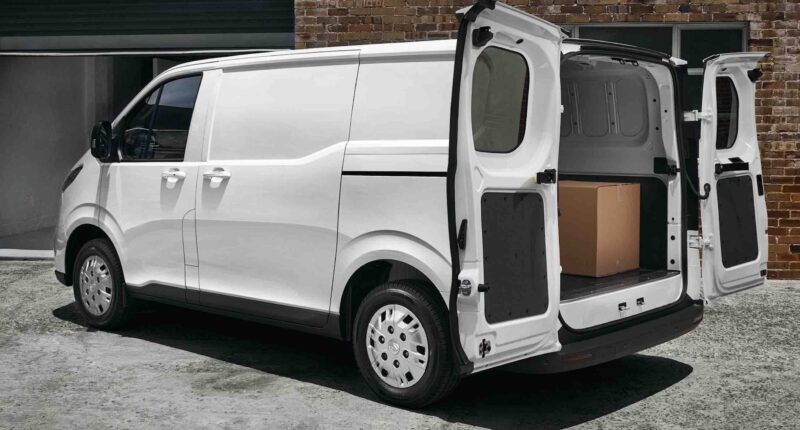As reported on by TheDriven recently, LDV have just launched their latest full electric van – the eDeliver 7, the baby brother to the eDeliver 9.
At 1150 kg to 1350 kg payload and offering between 5.9 and 8.7 cubic metres of load volume – the eDeliver 7 is the first electric van in the full 1 tonne, 6 to 8 cubic metre range to hit the market here. (The similarly sized Mercedes eVito is rated under 1t at 882kg).
Going by the number of vans that size to be seen on the road, it could well be the electrified van size many businesses and tradies have been waiting for.
As part of the vehicle’s launch, TheDriven recently attended a media drive day to get ‘up close and personal’ with the new eDeliver 7 range. This included a couple of hours behind the wheel of two (of the three) versions of the eDeliver 7 around the classic stomping ground for these vehicles – inner city roads and motorways.
Whilst it will be a little while before LDV get their press fleet around the country and I get to experience one for a week or so – I am putting together here a quick ‘first impressions’ article from that day.
The day started with a brief intro to the eDeliver 7 range and its future by LDV Australia general manager Dinesh Chinnappa followed by a walk-around of the van and its features by Shaun Garrard (Project Manager – New Ventures at Ateco). They were keen to make the points:
- The eDeliver 7 van was an EV design first with the diesel version being the ‘afterthought’. (The diesel Deliver 7 BTW will be offered late in 2024) and
- The eDeliver 7 was being very competitively priced (with a starting price of $59,990 to ABN holders/before on road costs).
With all three versions on offer, I opted to start with the SWB low roof.

With free reign to take the vans on any route to the lunch destination, I opted for a route of inner city roads through some of Sydney’s busiest, along with several side street with speed humps, uphill starts etc. In other words, the sorts of roads that Sydney is famous (infamous?) for.
For the return trip I had LWB, high roof version and took a route that included a significant proportion of 80 to 90km/h motorways.
Getting started
For a simple business oriented van, the cloth covered seats I found to be perfectly comfortable. Also, being cloth rather than vinyl, they will much appreciated when jumping into the vehicle on a typical hot summer day.
The driver’s seat offering the usual fore-aft and seat-back adjustment plus a base angle adjustment. Between these and the rake adjustment of the steering (no reach adjustment by the way) I found it quick to find a suitable driving position. Add-in electrically adjustable side mirrors and a standard centre mirror and I was quickly good to go.
Apple CarPlay and Android Auto are both built-in, with my Android phone seamlessly connecting via a wired connection. A quick test using an iPhone found CarPlay to connect just as easily. (Bluetooth synching is not available in the eDeliver 7).
The 31.2 cm (12.3 inch) touch screen also responded quickly and easily. Temperature and fan controls could be done both via the screen or via physical rollers on the dash.
On the slightly annoying side for a business oriented van (where drivers are likely to be swapping between vehicle models on a day-to-day basis) I did find some of the functions to be less than intuitive.

Volume control for the radio for instance involved pushing up or down a steering wheel rocker seemingly designed for left-right movement only, whilst some of the menus were accessed via pulling down from an almost unnoticeable bar at the top of the screen.
Given this was my first experience of the van – I would though have to say these were really only minor niggles. After all, two out of the three main functions that I think should have physical dash controls (heat, fan and volume) were there.
Driving
Like all electric commercial vehicles, the eDeliver 7 is far more responsive than its mostly turbo-diesel counterparts. Whilst the vans were unladen for the day, with 330 Nm of torque available from the get-go, I found both versions able to easily do a quick sprint off from the lights to slip in front of a slow-moving vehicle.
The vans were also light to steer and nimble in slow traffic situations. With a full suite of driver assist features, LDV claim the eDeliver 7 is at Level 2 of the 5 step autonomous driving scale.
Interestingly, I found the smallest of the three options (SWB, low roof) to have a quite firm ride with a tendency to bounce around slightly on rough surfaces, whilst the LWB high roof felt more planted on the road with far less tendency to bounce around.
The SWB version may very well relax with a bit of load and this will be something I check out during my coming longer term drive once test cars become available.
Price
Thus far, the business case for electric light commercial vehicles (e-LCVs) has been confined to cashed-up innovator and early adopter businesses who wanted to make (and/or be seen making) the environmentally ‘green’ choice. In other words, due to their high purchase prices, in many cases e-LCVs haven’t added up on overall ‘total cost of ownership’ (TCO) versus a diesel equivalent.
LDV, however, appear to have recognised that the general business vehicle buyer places overall ownership costs front and centre, as well as spotting this buyer segment will be the next tranche of potential commercial vehicle buyers.
As such, the eDeliver 7 van might just be what this group of buyers has been looking for in an electric van with a (just) sub-$60k starting price (before GST and on-road costs).
That places it at only 15% above the price for a similar sized Toyota Hiace diesel. (LDV suggesting the best comparison of the 7 was with a similar spec LWB Hiace). TCO – total cost of ownership – is however a very business-case specific calculation and for now I will leave TCO for the eDeliver 7 and other e-LCVs to a separate, more detailed, article.
Summing up:
Whilst I only had a brief time with the eDeliver 7, I found it to present and drive well. Given it includes all the modern features and safety aspects expected of a new business van – be it electric or internal combustion engined (ICE) – it would appear to be a viable contender for the business dollar, even if the choice between electric or ICE is simply a dollar driven one.
I will, however, be able to give a more nuanced answer to that question once I have spent a bit more time with one – plus done some number crunching for TCO and look at the possible business cases where electric could potentially come out ahead.

Bryce Gaton is an expert on electric vehicles and contributor for The Driven and Renew Economy. He has been working in the EV sector since 2008 and is currently working as EV electrical safety trainer/supervisor for the University of Melbourne. He also provides support for the EV Transition to business, government and the public through his EV Transition consultancy EVchoice.


